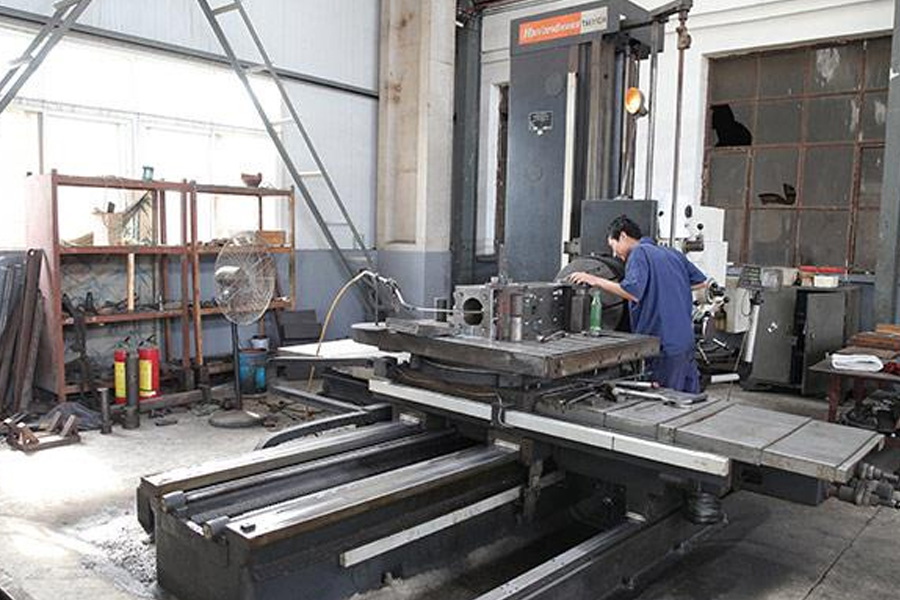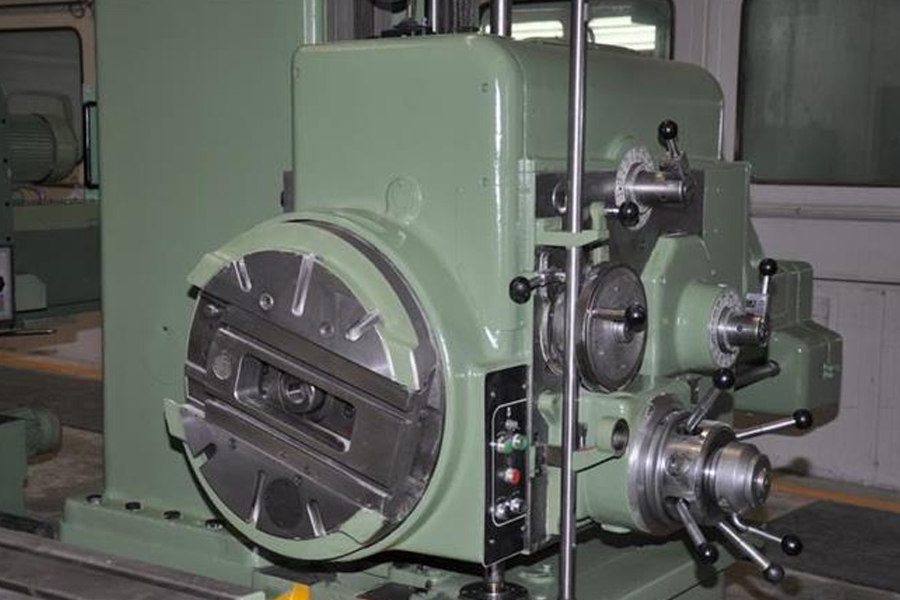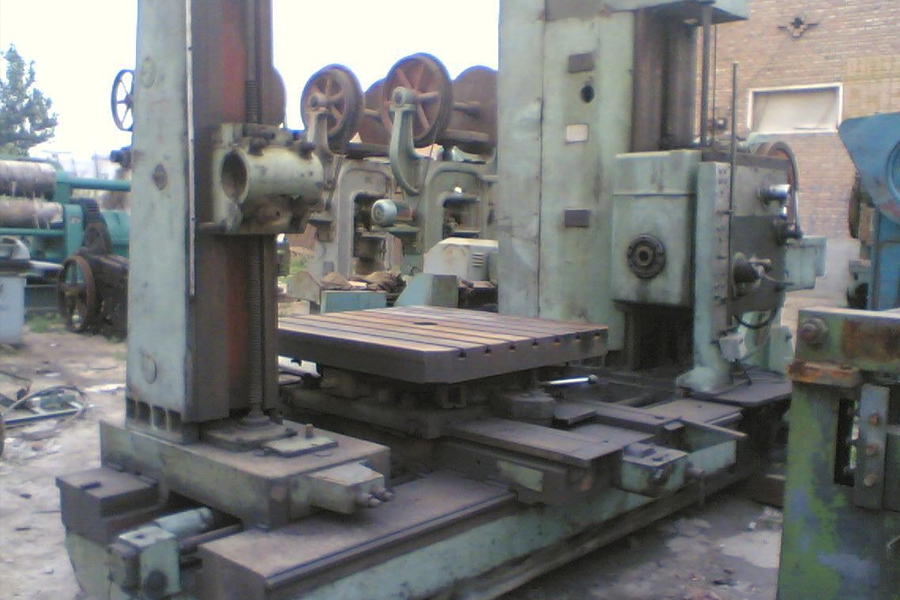Machine tool that mainly uses a boring tool to boring the existing pre-made holes of the workpiece. Generally, the rotation of the boring tool is the main motion, and the movement of the boring tool or the workpiece is the feed motion. It is mainly used to process high-precision holes or finish machining of multiple holes at one time. In addition, it can also be engaged in the processing of other machining surfaces related to hole finishing. Different tools and accessories can also be used for drilling, milling, and cutting. The machining accuracy and surface quality are higher than those of the drilling machine. Boring machine is the main equipment for processing large box parts. Thread and machining outer circle and end face, etc. Generally, the rotation of the boring tool is the main motion, and the movement of the boring tool or the workpiece is the feed motion. It is mainly used to process high-precision holes or finish machining of multiple holes at one time. In addition, it can also be engaged in the processing of other machining surfaces related to hole finishing. The use of different tools and accessories can also be used for drilling, milling, and cutting. Its machining accuracy and surface quality are higher than those of a drilling machine. Boring machine is the main equipment for processing large box parts. Thread and machining outer circle and end face, etc.
Boring machines are divided into horizontal boring machines, floor boring and milling machines, diamond boring machines and jig boring machines.

- ①Horizontal boring machine: a boring machine with the most applications and widest performance, suitable for single-piece and small-batch production and repair workshops.
- ②Floor boring machine and floor boring and Milling Machine: The feature is that the workpiece is fixed on the floor platform, which is suitable for processing workpieces with larger size and weight, and is used in heavy machinery manufacturing plants.
- ③Diamond boring machine: Use diamond or cemented carbide tools to boring holes with high precision and small surface roughness at a small feed rate and a high cutting speed. It is mainly used in mass production.
- ④ Coordinate boring machine: It has a precise coordinate positioning device, suitable for processing holes with high requirements for shape, size and hole spacing. It can also be used for marking, coordinate measurement and scale work, and is used in tool workshops and small and medium batch production. in. Other types of boring machines include vertical turret boring and milling machines, deep hole boring machines and boring machines for automobile and tractor repair.
List of Contents
The Development History Of Boring Machine
Due to the need to manufacture weapons, hydraulically driven barrel boring machines appeared in the 15th century. After J. Watt obtained a patent for a practical steam engine in 1769, the machining accuracy of the cylinder became a key issue for the steam engine. In 1774, the British J. Wilkinson (also translated as John Wilkinson) invented the barrel boring machine, which was used the following year to machine the cylinder block for the Watt steam engine. In 1776, he built a more accurate cylinder boring machine. Around 1880, the production of horizontal boring machines with front and rear columns and worktables began in Germany. In order to adapt to the processing of extra-large and extra-heavy workpieces, floor boring machines were developed in the 1930s. With the increase of milling workload, floor boring and milling machines appeared in the 1950s. At the beginning of the 20th century, due to the development of the clock and watch instrument manufacturing industry, equipment with smaller hole pitch errors was required, and coordinate boring machines appeared in Switzerland. In order to improve the positioning accuracy of the boring machine, optical reading heads or digital display devices have been widely used. Some boring machines also use digital control systems to realize coordinate positioning and process automation.
The Structural Features Of Boring Machine

The Structural Features Of Boring Machine
1. Long hole boring represented by the coaxial hole system of box parts is one of the most important contents in metal cutting.
Although there are still examples of long hole boring with boring dies, guide sleeves, long boring bars supported by a bench-type milling and boring machine, or manual alignment of the workpiece by 180° rotation, in recent years, on the one hand, due to CNC milling and boring machines and machining The extensive use of the center has greatly improved the coordinate positioning accuracy of various horizontal milling and boring machines and the rotary indexing accuracy of the worktable. Long hole boring is gradually being used by the highly efficient worktable rotation 180° self-positioning U-turn boring. On the other hand The mass production and application of ordinary or CNC planer-type milling and boring machines with curved bed layouts. From the structure of the machine tool, the self-positioning turning boring of the worktable by 180° has almost become the method of boring long holes on this kind of machine tool.
2. The coaxiality error and compensation of the column-feeding-turn boring hole and its compensation The main factors affecting the coaxiality of the milling and boring machine’s turning-head boring are the same as the bench-type milling and boring machine
The main factor affecting the coaxiality of the milling and boring machine is the same as the table-type milling and boring machine. It is also the indexing error da of the 180° U-turn of the worktable and the indexing error da and the boring before the turning. The axis of the half of the long hole d1 is turned around and coincides with the axis of the boring shaft again to boring the other half of the long hole d2, which requires a horizontal (x) movement of the worktable with a positioning error dx2 of Lx=2lx. Moreover, before and after the worktable is rotated by 180°, the inclination error df of the table in the xy coordinate plane, the inclination error dy in the yz plane and the translation error dy in the y direction are also the same for the planer type milling and boring machine. An important factor influencing the axis degree. However, the impact of the boring shaft axis space position on the coaxiality of the U-turn boring hole, the planer type milling and boring machine that usually uses the column to complete the full-length boring of the hole is obviously different from the bench type milling and boring machine that usually uses the worktable to move in the longitudinal direction.
3. Reasonable determination of the vertical position of the column when the boring shaft is fed
When encountering a specific situation, the milling and boring machine must fix the column at a suitable position on the longitudinal machine body, and use the boring spindle to bring the tool out as the feeding form of the boring, the axis of the boring spindle and the nominal axis of the bored hole are at xz The intersection angle error db in the plane and the intersection angle error dg in the yz plane are the same as the bench-type milling and boring machine. They have an important influence on the coaxiality of the U-turn boring. As the feeding length of the boring shaft increases, the weight of the boring shaft is increased. The downward deflection of the boring bar caused by it also has a greater impact on the coaxiality of the turning boring. Different from the bench type milling and boring machine, when the boring shaft of the planing type milling and boring machine extends out of the boring hole, the longitudinally movable column must be fixed at a certain position on the longitudinal bed, and the important thing is that this certain position can and should be select.
4. Reasonable determination of tool position on boring machine
When using column feed U-turn boring on a boring machine, the boring tool clamped on the tool bar of the boring shaft should have a reasonable position along the Z direction. On the one hand, the distance from the center of rotation of the tool tip to the front face of the spindle box should be slightly larger than Half of the full length of the hole (no matter how small it is, the long hole cannot be bored, and if it is too large, the rigidity of the boring shaft will decrease); on the other hand, the center of rotation of the tool tip must be placed at the intersection of the axis of the boring shaft and the vertical shift line O wait a minute.
The Classification Of Boring Machine

The Classification Of Boring Machine
1.Horizontal boring machine
Horizontal boring machine is one of the most widely used boring machines. It is mainly for hole processing, the boring accuracy can reach IT7, and the surface roughness Ra value is 1.6-0.8um. The main parameter of the horizontal boring machine is the spindle diameter. The boring shaft is arranged horizontally and performs axial feed, the headstock moves vertically along the front column guide rail, and the worktable moves longitudinally or horizontally for boring processing. This kind of machine tool is widely used and relatively economical. It is mainly used for hole processing of box (or bracket) parts and other processing surface Cnc Machining related to holes. The appearance is beautiful and generous, and the overall layout is well-balanced and coordinated. Rectangular guide rails are used for the bed, column and sliding seat, which have good stability. The guide rail is refrigerated and hardened with high wear resistance. Digital synchronous display, intuitive and accurate, can improve work efficiency and reduce costs
2.Coordinate boring machine
Jig boring machine is a kind of high-precision machine tool. Its structural feature is a precision measuring device with coordinate positions. The coordinate boring machine can be divided into single-column coordinate boring machine, double-column coordinate boring machine and horizontal coordinate boring machine. The boring machine with precise coordinate positioning device is mainly used for boring the hole system with high requirements of size, shape, especially position accuracy. It can also be used for precision coordinate measurement, template marking, scale and other tasks. Single-column coordinate boring machine: The spindle drives the tool to make the main rotation movement, and the spindle sleeve makes the feed movement in the axial direction. Features: Simple structure, convenient operation, especially suitable for processing precision holes of plate-shaped parts, but its rigidity is poor, so this structure is only suitable for small and medium-sized coordinate boring machines. Double-column coordinate boring machine: The tool is installed on the main shaft for the main movement, and the workpiece is installed on the worktable and moves longitudinally and linearly along the bed guide rail with the worktable. Its rigidity is good, and large-scale jig boring machines adopt this structure. The main parameter of the double-column coordinate boring machine is the width of the worktable. Horizontal coordinate boring machine: The worktable can rotate in the horizontal plane, and the feed movement can be realized by the longitudinal movement of the worktable or the axial movement of the spindle. Its processing accuracy is high.
3.Diamond Boring Machine
The diamond boring machine is characterized by a small feed rate and a high cutting speed for processing, so the processed workpiece has a high dimensional accuracy (IT6), and the surface roughness can reach 0.2 microns. Boring machine that uses diamond or cemented carbide tools to perform precision boring.
4.Deep hole drilling and boring machine
The deep hole drilling and boring cnc machine itself has strong rigidity, good precision, wide spindle speed range, and the feed system is driven by an AC servo motor, which can meet the needs of various deep hole processing techniques. The oil applicator is tightened and the workpiece is tightened with hydraulic devices, and the instrument display is safe and reliable. The following work forms can be selected:
- Workpiece rotation, tool rotation and reciprocating feed motion, suitable for drilling and small diameter boring;
- The workpiece rotates, and the tool does not rotate but only reciprocates, which is suitable for boring large diameter holes and nesting processing;
- The workpiece does not rotate, the tool rotates and the reciprocating feed movement is suitable for drilling and small diameter drilling and small diameter boring of complex workpieces. The workpiece is placed on the floor table, and the column moves longitudinally or laterally along the bed. Used for processing large workpieces. In addition, there are milling and boring machines that can perform milling, or deep hole drilling and boring machines that can perform drilling.
Please keep the source and address of this article for reprinting:Boring Machine
Reprint Statement: If there are no special instructions, all articles on this site are original. Please indicate the source for reprinting.:Cnc Machine Wiki,Thanks!^^
